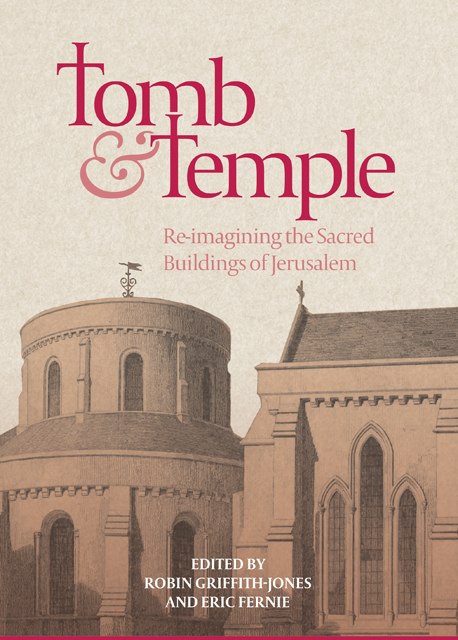Book contents
- Frontmatter
- Contents
- Illustrations
- Preface
- Contributors
- Abbreviations
- Editors’ Note
- Introduction
- Part I Re-presenting Jerusalem
- Part II The Church of the Holy Sepulchre
- Part III The Noble Sanctuary / The Temple Mount
- Part IV The Orthodox Churches
- Part V Round Churches in the West
- Appendix: The Knights’ Effigies: Newly Discovered Drawings by John Guillim, c. 1610
- Epilogue
- Index
- Already Published
6 - The Temple as Symbol, the Temple as Metaphor: Contrasting Eastern and Western Reimaginings
Published online by Cambridge University Press: 17 January 2023
- Frontmatter
- Contents
- Illustrations
- Preface
- Contributors
- Abbreviations
- Editors’ Note
- Introduction
- Part I Re-presenting Jerusalem
- Part II The Church of the Holy Sepulchre
- Part III The Noble Sanctuary / The Temple Mount
- Part IV The Orthodox Churches
- Part V Round Churches in the West
- Appendix: The Knights’ Effigies: Newly Discovered Drawings by John Guillim, c. 1610
- Epilogue
- Index
- Already Published
Summary
Metaphors are slippery things, at once allusive and elusive. Indeed, metaphors are by their very nature subversive: rather than telling us what something is, they tell us what it is not. Aristotle understood this; as he explains, ‘Metaphor consists in giving the thing a name that belongs to something else.’ Nevertheless, metaphors are a part of the language by which we construct the world as we perceive it. They both form our language and creatively transform it. By contrast, symbols seem more stable, more firmly grounded. A symbol can represent an abstract idea in concrete form, an intellectualized image; usually we can ‘see’ a symbol, whereas we can only imagine a metaphor. In the following short chapter, I shall attempt to come to grips with the rhetoric of architecture, looking at the idea of the Temple of Jerusalem as it was expressed in concrete form in Byzantine architecture. The Temple offers a unique perspective, for it survived more as a concept than as a reality. We can see its medieval replications, whereas we can only imagine its original appearance.
Historically, texts about buildings range from the purely descriptive to the vacuously allegorical. Both symbolic and metaphorical language has been used to explicate their physical appearance or to provide them with additional meaning. For the architectural historian, the rhetorical tradition may consequently provide both insights and confusions, for a text may be descriptive, symbolic, or metaphorical – or a combination of all three. The difficulty is to determine which is which. Although the language employed is almost never scientific, with both symbols and metaphors, some sort of resemblance is assumed. But does the application of an allegorical language to architecture automatically signal the replication of meaningful forms?
Symbols and metaphors may be difficult to pin down – both in texts and in buildings. By contrast, although a building may be the passive receptor of applied meanings, its architectural form is fixed and concrete. And although symbols and metaphors may be hard to isolate, their very elusiveness may also be the basis of their power. By definition and etymology, a metaphor transposes or transports its subject. A symbol, on the other hand, represents or associates a subject with something else, something that exists beyond it in time and space.
- Type
- Chapter
- Information
- Tomb and TempleRe-imagining the Sacred Buildings of Jerusalem, pp. 146 - 158Publisher: Boydell & BrewerPrint publication year: 2018

